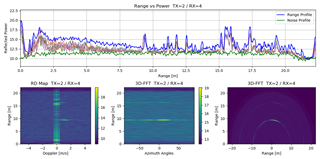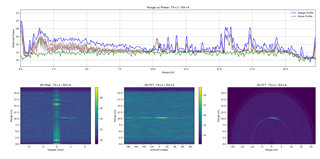Other Parts Discussed in Thread: DCA1000EVM,
Hello,
I run a BPM based raw ADC capture by using IWR1642Boost and DCA1000EVM. The scence was clear, only one person was moving away from the radar at the boresight.
I referred this post for BPM decoding.
My settings for BPM were
ar1.ChanNAdcConfig(1, 1, 0, 1, 1, 1, 1, 2, 1, 0)
ar1.ProfileConfig(0, 77, 7, 5, 87.3, 0, 0, 0, 0, 0, 0, 42, 0, 512, 6250, 0, 0, 30)
ar1.ChirpConfig(0, 1, 0, 0, 0, 0, 0, 1, 1, 0)
ar1.BpmConfig(0, 0, 0, 0, 0, 0, 0, 0)
ar1.BpmConfig(1, 1, 0, 0, 1, 1, 0, 0)
ar1.FrameConfig(0, 1, 300, 32, 100, 0, 0, 1)
My decoding steps are
(1)
RX1: Sa Sb Sa Sb Sa Sb Sa Sb ...
RX2: Sa Sb Sa Sb Sa Sb Sa Sb ...
RX3: Sa Sb Sa Sb Sa Sb Sa Sb ...
RX4: Sa Sb Sa Sb Sa Sb Sa Sb ...
(2)
RX1: TX1 TX2 TX1 TX2 TX1 TX2 ...
RX2: TX1 TX2 TX1 TX2 TX1 TX2 ...
RX3: TX1 TX2 TX1 TX2 TX1 TX2 ...
RX4: TX1 TX2 TX1 TX2 TX1 TX2 ...
where TX1 = 0.5*(Sa+Sb) and TX1 = 0.5*(Sa-Sb)
(3)
RX1: TX1 TX1 TX1 TX1 ...
RX2: TX1 TX1 TX1 TX1 ...
RX3: TX1 TX1 TX1 TX1 ...
RX4: TX1 TX1 TX1 TX1 ...
RX5: TX2 TX2 TX2 TX2 ... (extract TX2 from RX1)
RX6: TX2 TX2 TX2 TX2 ... (extract TX2 from RX2)
RX7: TX2 TX2 TX2 TX2 ... (extract TX2 from RX3)
RX8: TX2 TX2 TX2 TX2 ... (extract TX2 from RX4)
It results in 300 x 32 x 8 x 512
I have two questions.
(1) After radar data processing, I found the moving target was mixed with the range profile (zero-Doppler bin). For example, the moving target is at 10m around. In the Range vs Power plot the moving target was mixed with zero-Doppler bin, which I think it is wrong (1st pic). However, with the TDM setting, moving target was not mixed with zero-Doppler bin, which is correct (2nd pic).


From my understanding, to get the Range vs Power plot Doppler correct is not necessarily applied.
Is there any step that I was missing for BPM decoding so that the moving target mixed with the zero-Doppler bin?
(2) From the MIMO Radar pdf (https://www.ti.com/lit/an/swra554a/swra554a.pdf?ts=1649918331937&ref_url=https%253A%252F%252Fwww.google.com%252F),
on page 7, it says BPM has a benefit of 10log10(NTX) compared with TDM configuration.
How should interpret/understand this? In other words, which value I should use to compare between BPM and TDM that related to 10log10(NTX)?
Thank you very much for the help!
Best,
Hang



